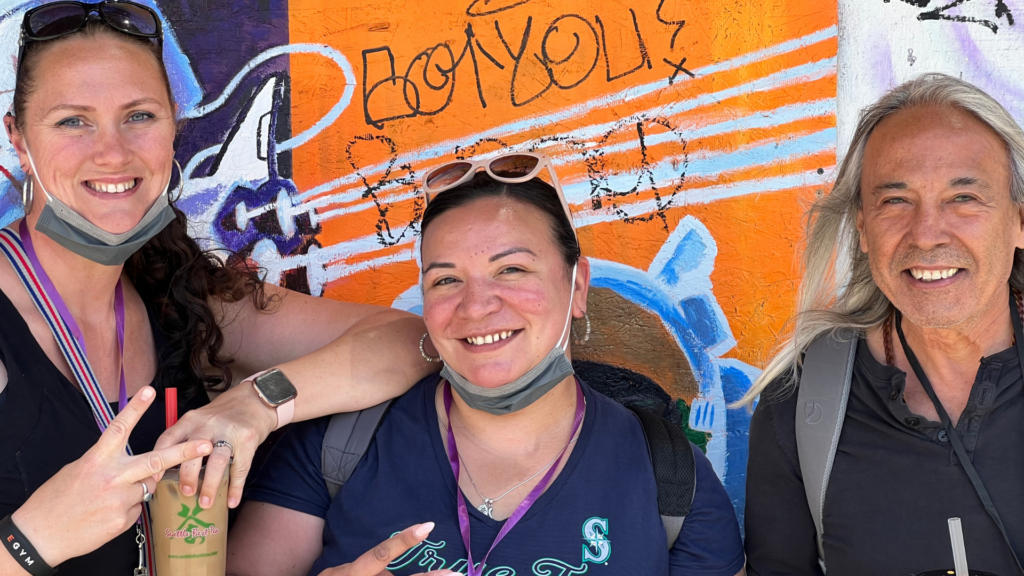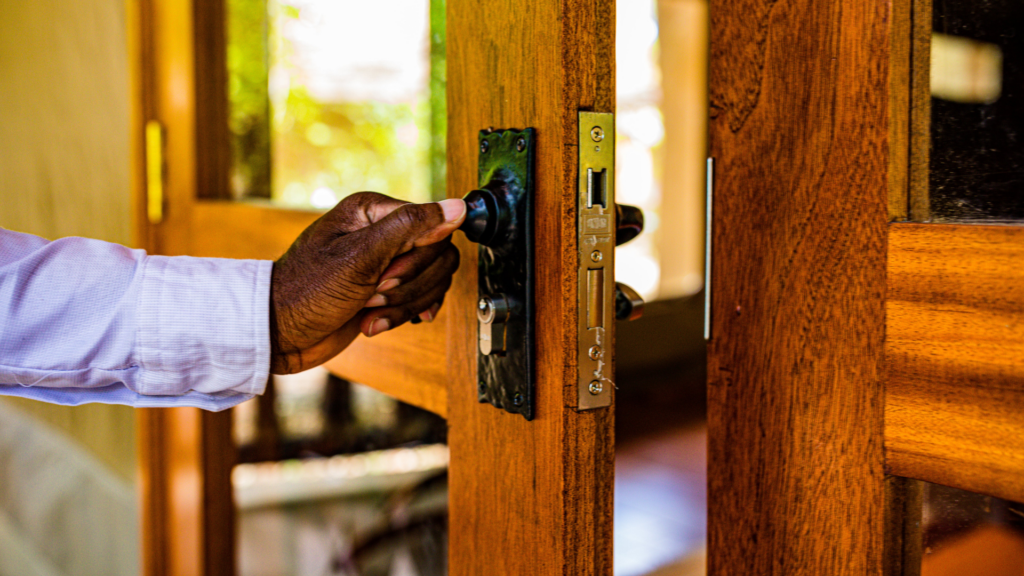When Ibrahim walked into his Seattle apartment on move-in day, the weight of being unhoused lifted from his body. The moment was the culmination of what he’d been working towards for the last six years. He had come close a few times before but couldn’t get everything lined up — an apartment and employment — simultaneously. Now that he’s inside, he has time and space to focus on a new chapter of life.
“I feel comfortable. Being homeless, you’re not comfortable. It’s always something,” he shared. “There’s nowhere to go. It’s raining, or it’s cold.”
Ibrahim, who asked us not to include his real name, met King County Regional Homeless Authority (KCRHA) Systems Advocate Philicia Jenny last November. He had been living in an encampment near the stadium district in Downtown. He described the offer to move into housing as a “gift from God.” Because he already had photo identification, the process moved quickly. Philicia added him to the By-Name List, completed the Housing Needs Form, and identified potential units he could move into.
When he viewed the one-bedroom apartment he now lives in, he immediately said yes. It met his needs and is in a neighborhood close to public transit and employment opportunities. Philicia inspected the apartment to make sure it met HUDs requirements. After the housing provider approved his application. Ibrahim signed a 12-month lease. In just two weeks, Ibrahim went from street to housed, a major, positive life change. To help ease the transition, Philicia ensured Ibrahim had everything he needed, from groceries to furniture.
Today he’s settled in and has a routine. He works part-time on the weekends. On his days off, he picks up flex jobs and searches for full-time employment. No longer encumbered by the challenges of living outside in a tent, he’s focusing on himself. He’s paying off incarceration-related fines and keeping a positive outlook.
“It was a miracle to get a place,” he added. “I can focus on myself, work on myself. I’m trying to save what I can.”
Ibrahim has an associate degree and is looking into going back to school to learn a new skill set so he can improve his job prospects.
Partnership for Zero
The effort to house Ibrahim and many others is part of Partnership for Zero, a public-private collaboration to dramatically reduce unsheltered homelessness Downtown. Led by KCRHA, We Are In, and the Washington State Lived Experience Coalition Seattle/King County Chapter (LEC), Partnership for Zero uses the evidence-based Housing First Model. The goal is to move people into permanent housing first and then leverage the stability of housing to address any health care, recovery, employment, or other service needs a person might have.
In August 2022, the Systems Advocate (SA) team began canvassing the catchment zone. They focused on identifying encampments, engagement through outreach and events, and adding unhoused people to the By-Name List. Later, they began working at prioritized sites such as the one Ibrahim lived.
The Housing First model made an immediate impact on folks living unsheltered. The offer from Systems Advocates was different from what they’d heard in the past from outreach teams.
“It was shocking to people that we were talking about moving into housing or permanent supportive housing. Because usually, people offer shelter,” said Damien Keitt, Lead Systems Advocate. “Being on the other end, it’s amazing because this is what I wanted to do even before I was unhoused, just being in a position to help people.”
Foundation for Success
Developing critical infrastructure is the foundation of Partnership for Zero’s success. Since launching, key elements are in place and laying the foundation for scale.
The Housing Command Center (HCC) — opened its doors in September 2022 with operational guidance and support from the U.S. Department of Housing and Urban Development (HUD). Taking best practices learned from years of emergency response to disasters like floods, fires and other major displacements, the HCC is streamlining and coordinating the process of getting people housed. This involves real-time visibility into housing inventory and rapidly engaging, matching, and moving people who have been living unsheltered into appropriate housing with services.
Part of what makes this different from typical homelessness response is the addition of people with lived expertise of homelessness at the decision-making tables for this work, ensuring that the voices of our unhoused neighbors are included at every level of the process.

Systems Advocates use a peer navigation model to do outreach to our unhoused neighbors, assist them in the process of getting housed, and provide long-term support. The 26 Systems Advocates, all of whom have their own lived experience of homelessness, are able to build the trust that is essential to helping people with complex needs access and navigate social services and pathways to housing.
Systems Advocates partner with the City of Seattle’s HOPE Team, and contracted outreach providers PDA and REACH to engage with people living unsheltered, help people obtain necessary identification documents, complete a “Housing Needs Form” to determine what types of housing is desired and appropriate, and fill out application forms for housing units.
After individuals are successfully moved into permanent housing, Systems Advocates continue to support them for a year to ensure ongoing stability. Systems Advocates are also living proof that any person experiencing homelessness can — with the right support — rebuild their lives. So far, Systems Advocates have logged more than 13,000 hours in the field and have engaged with at least 933 individuals.
Quality, reliable data is essential to problem-solving, so the Housing Command Center has built a “By-Name List” (BNL) which details granular information about what each person experiencing homelessness needs in order to move to stability. Our community has never before had data with this level of detail.
As of this month, the Systems Advocates have added 933 people to the By-Name List, providing a full picture of the size and scope of the need. Notably, 243 or 26% of this group have never accessed services before — proof that intentional, human-centered outreach is key to moving people from homeless to housed. The new Outreach Module built into KCRHA data management systems, the ability of Systems Advocates to gather and enter data in real-time in the field, and the quality of the data captured in the BNL represents significant progress and is essential to Partnership for Zero’s success moving forward.
“Through partnership and collaboration, our community has implemented something that has never been done before,” said Marc Dones, CEO of KCRHA. “We are learning and improving, we are making real, clear progress, and other jurisdictions are following our lead. This is the kind of collective action that can solve complex problems like homelessness.”
Progress Snapshot as of February 2023
With this foundation firmly in place, KCRHA is moving unsheltered residents in Downtown Seattle and Chinatown/ID into housing:
- 152 individuals, couples and families have been moved inside.
- 214 people living unsheltered are moving through the housing process at two prioritized sites (specific encampments or geographic areas).
- 56 people have signed 12-month leases in permanent housing (both private market and permanent supportive housing).
- 201 people who previously did not have vital identification documents are now document ready, meaning, they have the documentation (i.e. social security card, birth certificate, photo identification) that is required for rental applications, health care, recovery or employment services, and reintegration into community.
- 302 people have filled out the Housing Needs Form, a questionnaire to help Systems Advocates identify an unhoused person’s needs from service connection to the type of housing that works best for them.
The future for Ibrahim
Every time a person moves into a place they can call home, we are fulfilling our commitment to the community. We’ve streamlined the process and made adjustments when needed to address a solvable crisis. While the process varies for each individual, we are identifying system challenges and making the changes necessary to streamline the process and move people inside.
Now that Ibrahim is housed, he’s rebuilding his life. Because he’s no longer in survival mode, he can also focus on what brings him joy. During his downtime, he likes to watch documentaries or go out for a walk.
Given Ibrahim’s challenges, he’s thankful for the opportunity to move inside. He’s also appreciative of System Advocate Philicia Jenny. He said she went above and beyond. When asked what he’d like others to know about our unhoused neighbors, here’s what he shared.


